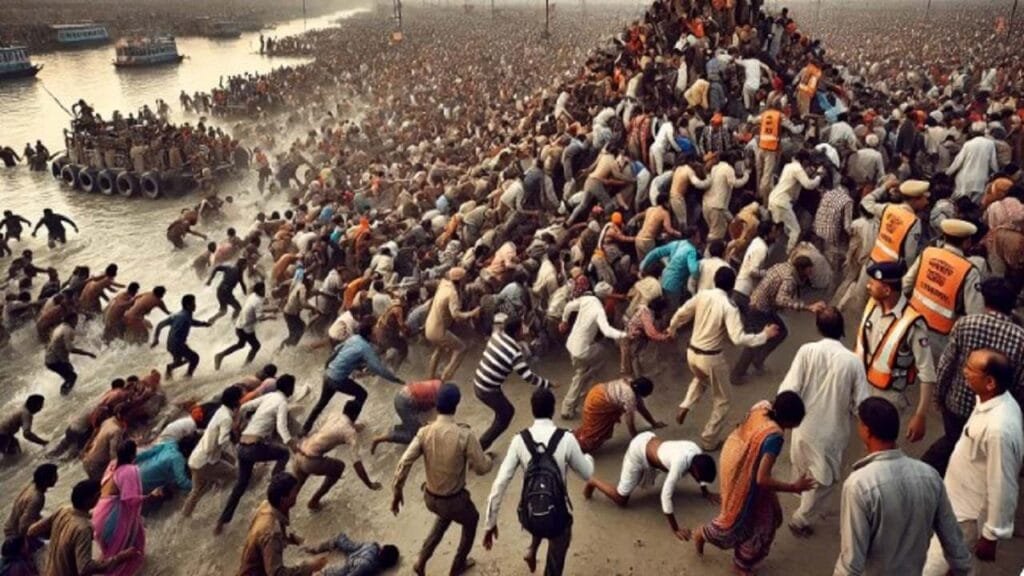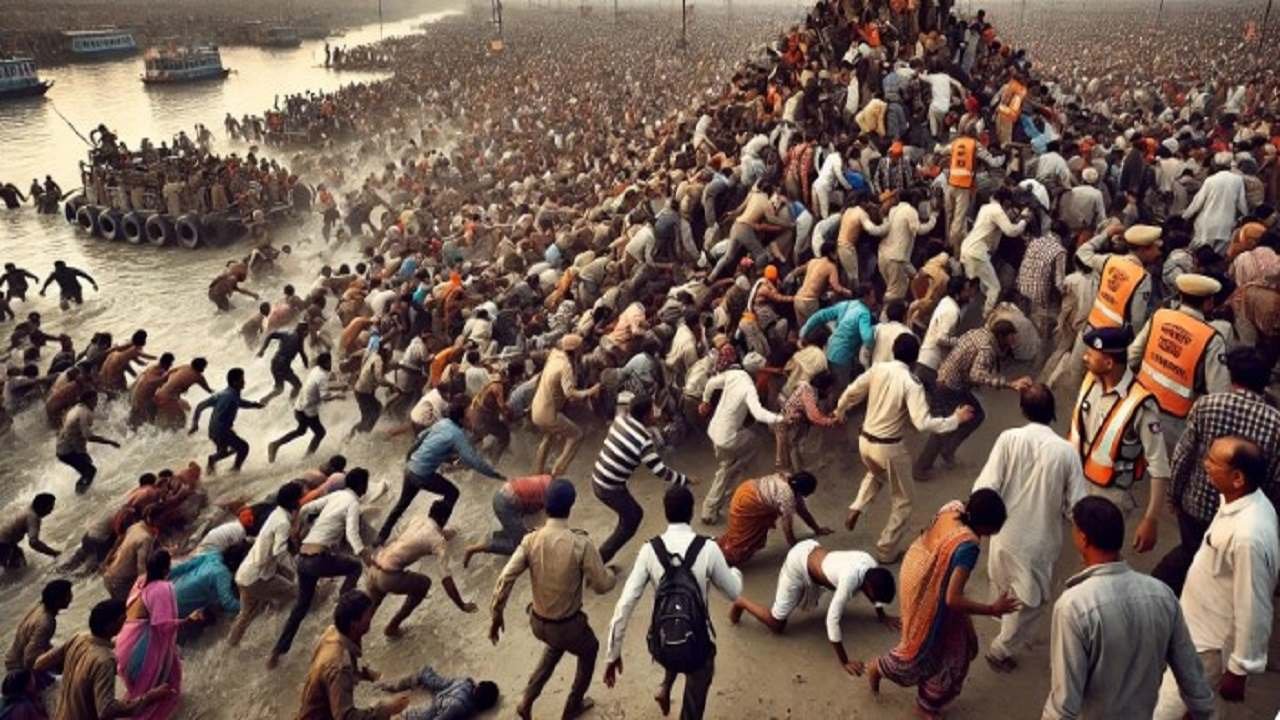The Maha Kumbh Mela Stampede– The Maha Kumbh Mela, one of the largest spiritual gatherings in the world, draws millions of pilgrims from across the globe. While it is a sacred and joyous occasion for devotees, it has unfortunately witnessed tragic stampedes over the years, resulting in numerous deaths and injuries.
The Tragic History of The Maha Kumbh Mela Stampede
Over the years, the sheer scale of the crowd and the overwhelming rush of devotees during auspicious bathing rituals have led to several devastating stampedes. The most notable incidents include:
1954 Stampede: In this early tragedy, over 500 people lost their lives in a stampede during the Kumbh Mela in Haridwar. A massive crowd tried to rush towards the holy river for the ceremonial dip, causing chaos.
2013 Allahabad Kumbh Mela: One of the deadliest stampedes in recent history occurred in 2013, when over 36 people were killed in a tragic incident. This stampede was triggered by a sudden surge of pilgrims at the railway station.

Other Notable Incidents: The Kumbh Mela has experienced smaller stampedes, where dozens of lives have been lost, particularly during peak bathing dates. These stampedes often occur due to lack of proper crowd control, unexpected rush, and logistical challenges.
Why Do These Stampedes Happen?
Several factors contribute to the dangerous situations at the Kumbh Mela:
Overcrowding: With millions of people converging at a single location, it becomes extremely difficult to manage the crowd. Limited infrastructure, narrow roads, and a lack of proper crowd management measures often make the situation worse.
Rush During Auspicious Days: Certain days, like the Mauni Amavasya, attract the highest number of pilgrims. The pressure to get to the river for a holy dip causes people to push and shove, leading to stampedes.
Inadequate Facilities: While efforts have been made to provide adequate facilities, in many cases, the number of temporary structures like footbridges and tents are not enough to handle such large crowds.
Safety Measures to Prevent Stampedes
In recent years, authorities have made significant efforts to prevent such tragedies and ensure the safety of the pilgrims:
- Enhanced Crowd Management: Authorities now implement stricter crowd management strategies, including barricades, more entry/exit points, and real-time monitoring of crowd movements.
- Advanced Technology: The use of drones and CCTV cameras has helped in monitoring crowd density and identifying areas where people are at risk. This allows for early intervention.
- Increased Police Presence: More security personnel are deployed to ensure that the crowds move in an orderly fashion. Police and volunteers are stationed at strategic locations to guide people and prevent panic.
- Better Infrastructure: Authorities have worked on improving the infrastructure, including better roads, sanitation, and health facilities, to cater to the needs of the huge number of pilgrims.
- Public Awareness Campaigns: Pilgrims are often advised to follow safety protocols, such as staying in groups, avoiding pushing, and being aware of emergency exits.
A Call for Caution
Despite these efforts, the risk of stampedes still exists, and the loss of life in past Kumbh Melas serves as a stark reminder of the dangers posed by such massive gatherings. Pilgrims are urged to stay cautious, follow safety measures, and report any signs of danger.
As we look ahead to the next Maha Kumbh Mela, it is essential that both the authorities and the pilgrims work together to ensure a safe and secure environment for all. Only then can this sacred event continue to be a source of spiritual renewal without the shadow of tragedy hanging over it.
Let us hope that the lessons learned from past tragedies will continue to shape the safety measures for future Kumbh Melas, ensuring that this monumental event remains a celebration of faith and unity, free from avoidable loss of life.
Next Maha Kumbh Mela After 2025 (144 Years Later)
The Maha Kumbh Mela is a significant religious event that occurs once every 12 years at one of four sacred locations in India: Prayagraj (Allahabad), Haridwar, Ujjain, and Nashik. The upcoming Maha Kumbh Mela will take place in 2025 at Prayagraj, marking the next grand gathering of millions of Hindu devotees. However,
if we look 144 years ahead, the next Maha Kumbh Mela after the 2025 event will occur in 2169. This rare interval highlights the immense cycle of the Kumbh Mela, which is based on the alignment of celestial bodies and astrological calculations.
The Kumbh Mela not only represents a grand spiritual and cultural festival but also symbolizes the continuity of faith and traditions that have persisted for centuries. The event in 2169 will undoubtedly be a major milestone, continuing the legacy of the grand gatherings held at sacred river sites, offering devotees a chance to cleanse their sins and seek spiritual salvation.
Official Website– Click Here
1. What is the Maha Kumbh Mela?
The Maha Kumbh Mela is a large-scale religious festival held every 12 years at one of four sacred locations in India. Millions of Hindu pilgrims gather to bathe in the holy rivers, believing it purifies them of their sins and grants them spiritual merit.
2. Where does the Maha Kumbh Mela take place?
The Maha Kumbh Mela takes place at four locations:
- Prayagraj (Allahabad), where the Ganges, Yamuna, and mythical Saraswati rivers converge.
- Haridwar, located on the banks of the Ganges River.
- Ujjain, on the banks of the Shipra River.
- Nashik, on the banks of the Godavari River.
3. How often is the Maha Kumbh Mela held?
The Maha Kumbh Mela is held once every 12 years at each of the four locations. Smaller Kumbh Melas occur at the same locations during the intervening years, but the Maha Kumbh is the largest and most significant.
4. Why is the Maha Kumbh Mela so important?
The Maha Kumbh Mela is considered one of the largest spiritual gatherings in the world. Hindus believe that taking a dip in the holy river during the event can cleanse them of sins, grant them salvation, and ensure a better life in their next incarnation.
5. What precautions should be taken during the Maha Kumbh Mela?
Due to the massive crowds, safety is a concern. Pilgrims should:
- Stay hydrated and carry basic necessities.
- Follow safety guidelines and avoid getting lost in the crowds.
- Be cautious during the holy dips to avoid accidents or stampedes.
- Follow all health and safety protocols, especially during pandemic situations.
